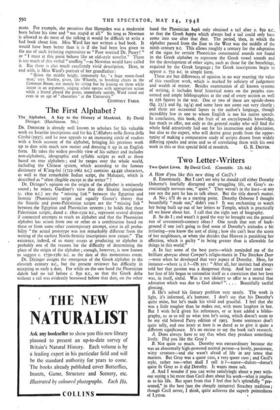The First Alphabet ?
DR. DIR1NGER is already well known to scholars for his valuable work on Israelite inscriptions and for his L'Alfabeto nella Storia della Civiltd (i937), and he now appeals to an increasing circle of readers with a fresh account of the alphabet, bringing his previous work up to date with much new matter and dressing it up in an English form. He takes the widest possible view of his subject and includes non-alphabetic, ideographic and syllabic scripts as well as those based on true alphabets ; and he ranges over the whole world, including the Chinese system, which according to the famous dictionary of K'ang-hsi (1722-1662 B.C.) contains 44,449 characters, as well as that remarkable Indian script, the Mahajani, which is described as " often illegible except to the writer " !
Dr. Diringer's opinion on the origin of the alphabet is eminently sound ; he rejects Gardiner's view that the Sinaitic inscriptions
(c. 1800 B.C.) are the " missing link " between the Egyptian and Semitic (Phoenician) script and equally Gaster's theory that the Sinaitic and proto-Palestinian scripts are the "missing link " between the Egyptian and Phoenician systems ; he holds that these Palestinian scripts, dated c. 1800-1500 B.C., represent several distinct if connected attempts to reach an alphabet and that the Phoenician alphabet has arisen from one or other or a combination based on these or from some other contemporary attempt, since in all proba- bility " the actual prototype was not remarkably different from the writing of the earliest North-Semitic inscriptions now extant." The existence, indeed, of so many essays at producing an alphabet is probably one of the reasons for the difficulty of determining the place of the origin of the alphabet ; enough, however, is now known to suggest c. 1730-158o B.C. as the date of this momentous event.
Dr. Diringer assigns the emergence of the Greek .alphabet to the eleventh century B.C., but the present reviewer has difficulty in accepting so early a date. For while on the one hand the Phoenician daleth had no tail before c. 85o B.C., so that the Greek delta without a tail was evidently borrowed before that date, on the other hand the Phoenician kaph only obtained a tail after c. 850 B.C., so that the Greek kappa which always had a tail could only have come into use after that date. The period, then, in which the alphabet passed from the East to the West was the middle of the ninth century B.C. This allows roughly a century for the adaptation of the signs for certain Phoenician consonantal sounds not found in the Greek alphabet to represent the Greek vowel sounds and for the development of other signs, such as those for the breathings, required by the Greek language ; for Greek inscriptions begin to appear c. 750 B.C. in simple form.
These are but differences of opinion in no way marring the value of this excellent work, which is marked by sobriety of judgement and wealth of matter. Besides examination of all known systems of writing, it includes brief historical notes on the peoples con- cerned and ample bibliographies at the end of every section as well as 256 figures in the text. One or two of these are upside-down (fig. 23/3 and fig. 24/4) and some have not come out very clearly - and there are occasional lapses in the author's language, ,though incredibly few in one to whom English is not his native speech. In conclusion, this book, the fruit of an encyclopaedic knowledge, has much to offer, not only to the .general reader who will find the whole field attractively laid out for his instruction and delectation, but also to the expert, who will derive great profit from the oppor- tunity of making a comparative study of scripts drawn from widely differing epochs and areas and so of correlating them with his own work in this or that special field of research. G. R. DRIVER.






























 Previous page
Previous page